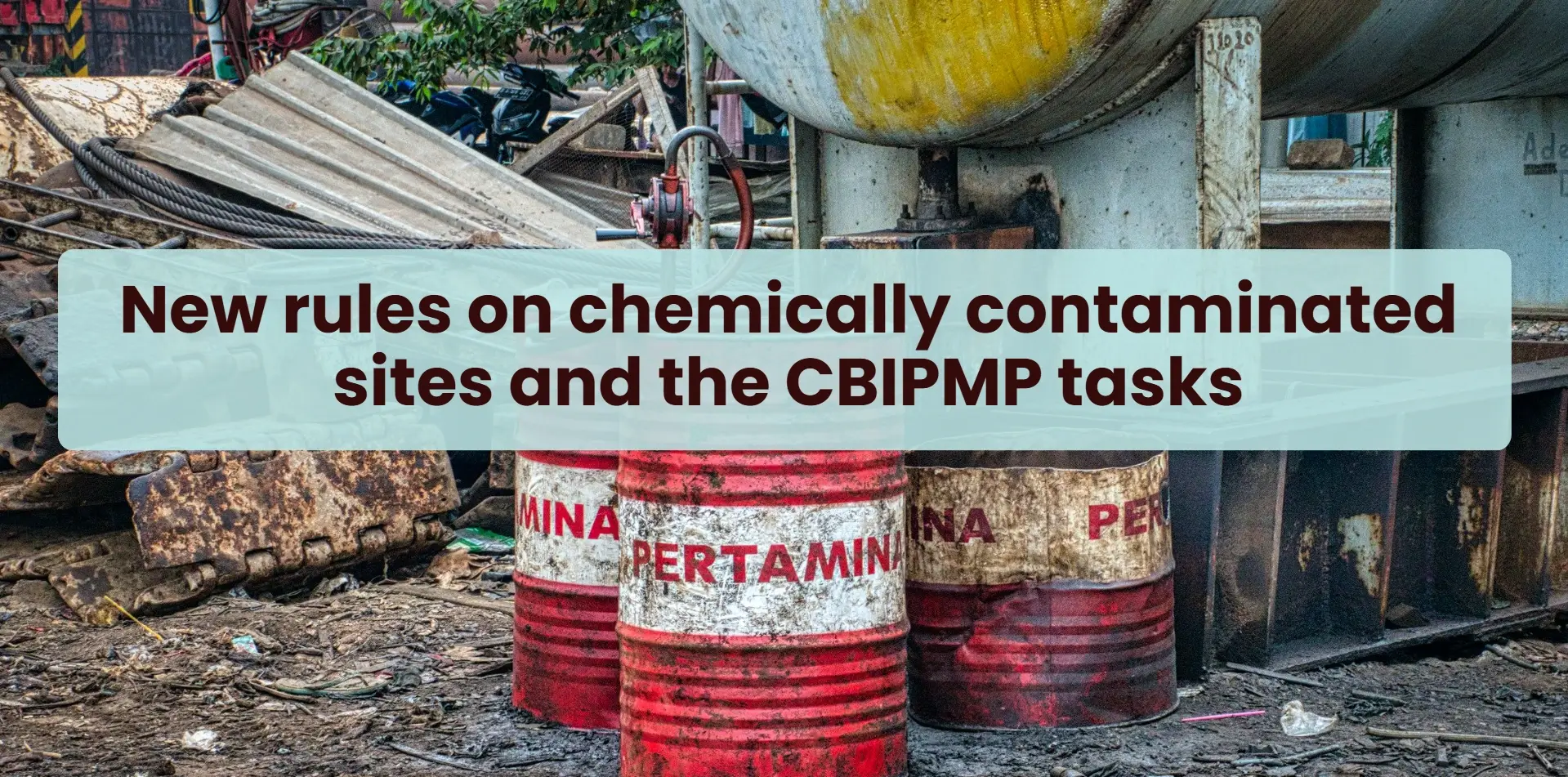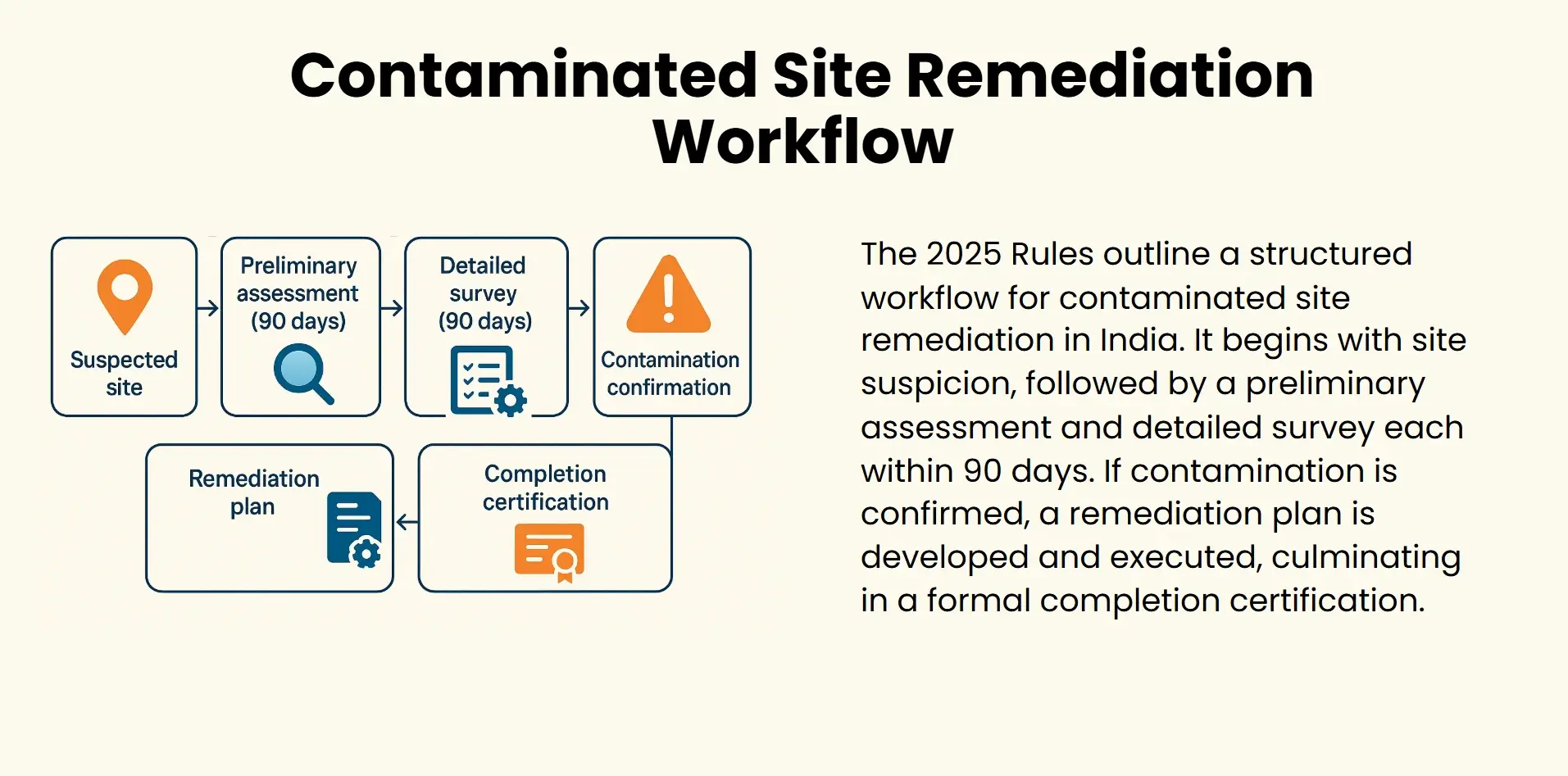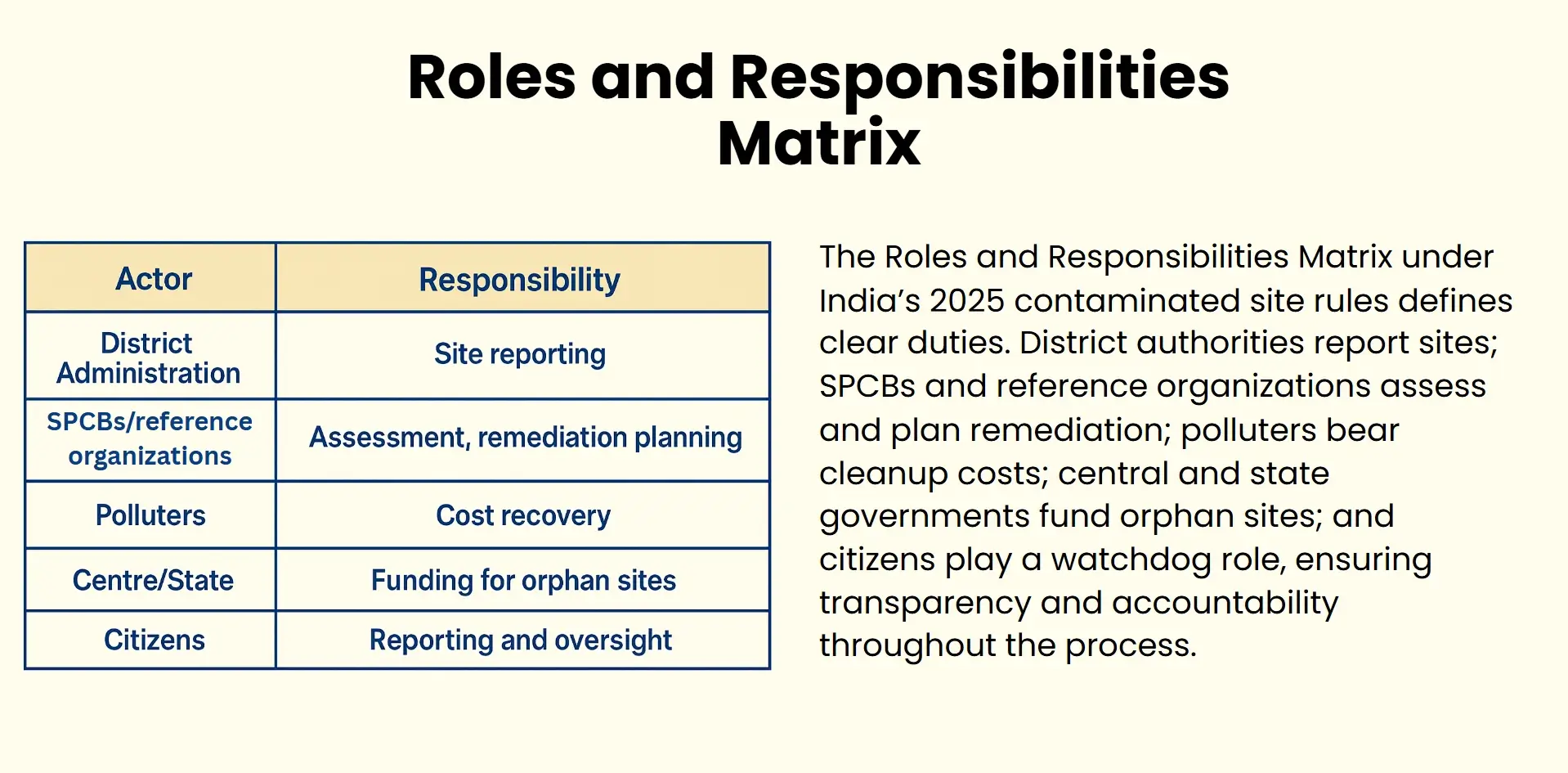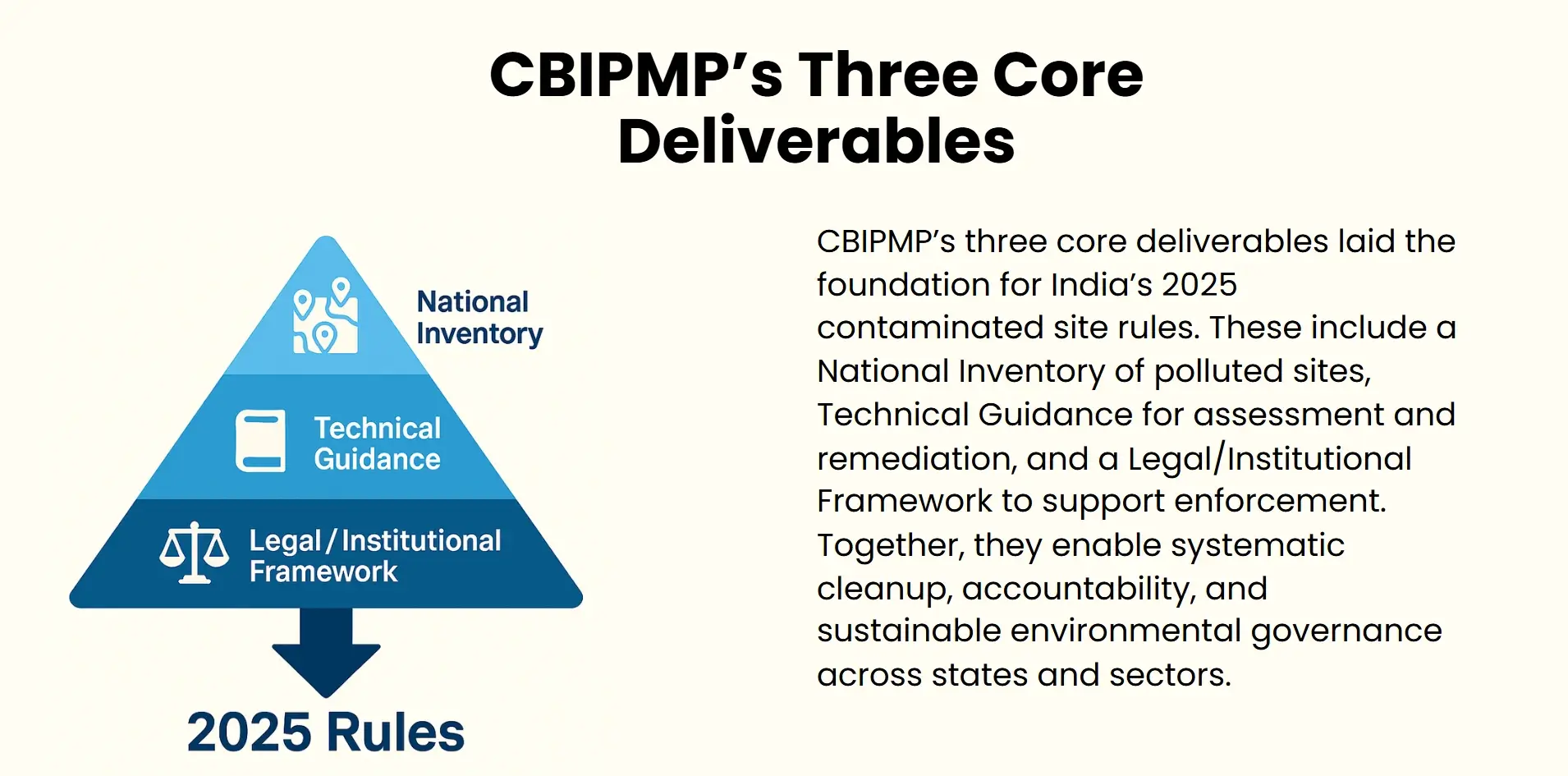New rules, "The Environment Protection (Management of Contaminated Sites) Rules, 2025. The 2025 rules in India establish a legal means of cleaning up chemically polluted locations, building upon the work done by CBIPMP in its procedures that focus on inventory, policies, and strategies of corrections. Fulfills Legal GapFirst dedicated law to manage chemically contaminated sites.

The legacy of chemically contaminatedsites is being left behind in the face of an increased industrial footprint in India, which has a severe impact on the health of the people, the ecosystem and groundwater. Understanding the need for this situation, the MoEFCC has introduced the 2025 Rules. This set of regulations is a major policy change, and it lays a legal foundationfor how to identify, measure and clean up polluted land in the entire nation. They adhere to the framework created by the World Bank-assisted CBIPMP, which helped develop inventories, technical guidelines, and pilot remediation projects in highly polluted areas.The 2025 Rules seek to defragment the roles of central and stateagencies, set specific remediation schedules and embrace best available technologies. Notably, they also present the polluter pays principle, where the industries need to pay to tidy up the pollution. Conducts preliminary assessment within 90 days. This regulatory action places India at par with the international best practices of environmental governance and represents an increasing determination to move towards sustainable development. With Indian industrialization in progress, adoption of these rules will play a critical role in resolving the need to maintain economic development and integrity with the ecology and protecting the communities.
Why these Regulations, Whynow?
India is at a turning point: The industry out-grew protection and left poisonous footprints. The 2025 contaminated sites rules are at last translating decades of pilot lessons into enforceable and time-bound clean-ups.
Policy vacuum and contamination of legacy
India has had no statutory procedure to identify, evaluate and remediate the land that is chemically contaminated yet the authorities reported cases of dozens of chemically contaminated land. The gap is filled by the new Environment Protection(Management of Contaminated Sites) Rules, 2025. They react to a backlog in which 103 contaminatedsites have been identified, off which only a few have been started off by remediation, which reiterates the need of binding framework and a more well defined responsibility. Codification of procedures will cause India to get out of ad hoc clean-up and into systemic clean-up.
Costs, accountability and public health
Hazardous dumpinghas polluted the soil, ground and surface water at the risk of populations and ecological systems. The regulations give practical application to the principles of the polluter pays: the responsible party pays to conduct risk evaluation, clean-up and post-remediation monitoring; in case polluters cannot be traced or are financially bankrupt, governments intervene to make sure something is done. Timeline-specific measures, like a 90-day initial evaluation, prevent drift and increase the validity and enforceability of health risk mitigation. Such a combination of liability and public backstops addresses not only orphan sites, but also industry non-compliance.
Legal codification and institutional readiness
Since 2010, the Capacity Building for Industrial Pollution Management Project had produced inventories and technical advice, a legal spine was lacking. That loop is filled in by the 2025 regulations, which provide enforcement of the technical expertise by assigning specific powers and liability in the process. They were notified in late July 2025 under the Environment (Protection) Act and now apply nation-wide, with certain specified exclusions, offering long horizons of remediation with certainty in the law.
Global alignment and people engagement
By omitting areas already covered by other legislative bodies (radioactive wastes, mining, oil pollution at sea, and the so-called landfills) the framework locates capacity in the areas where it would be most utilized. Most importantly, citizens are able to initiate action: local authorities publish suspected locations on a single portal; State Control Boards are required to perform initial assessments within 90 days following which remediation plans and schedules should be put in place. This transparency, combined with goals set in line with the SDGs on health, water and responsible production, increases accountability and ambition.
The Environment Protection (Management of Contaminated Sites) Rules, 2025
The new Rules, 2025 in India are a turning point in the regulation of Environmental Protection. The country now has a framework that requires, within the confines of the law, how to identify, evaluate and correct chemically contaminated sites one that makes decades of pilot studies and draft policies a reality in the form of enforceable action.
The scope and the extent
The regulations focus on chemically polluted ground on which past dumping or spillage of hazardous waste has poisoned the soil, underground or surface water. They specifically excludeareas that are already relegated to other jurisdictions, like radiation waste, hard rock mining, offshore pollution, and approved municipal landfills, and primarilyfocus capacity on chemical remnants. The narrowing of scope can prevent overlap by regulators, diminish procedural conflict, and focus specialised procedures and budgets on the sites that have the greatest potential chronic exposure hazards.

Legal basis and extent
The rules under the Environment (Protection) Act, 1986, notified these as contaminated sites,which,, strictly speaking,include some places where hazardous chemical waste has been historically polluting the soil, groundwater, or surface water. They are forgotten landfills, spill areas, derelict industrial building areas, and unlawful waste sites. Nevertheless, the regulations do not cover contamination of radioactive waste products, mining activities, maritime pollution of oil, and landfills of waste belonging to municipal waste disposal, among others, as they are subject to other laws.
Identification and Assessment Protocol
The district administrations have to report on a half-yearly basis, with the list of suspected contaminated sites. After receiving these, the State Pollution Control Boards (SPCBs) or the reference organisation that is appointed should then preliminarily assess the same within 90 days. In case of the likelihood of contamination, a detailed surveyhas to be carried out in the subsequent 90 days. Any of the 189 hazardous chemicals in the schedule in the 2016 Hazardous Waste Rules above the level of safety established by the rules establishes contamination.
Access and Disclosure
When a site has been declared contaminated, it must be publicly disclosed where it is located. Governments should ensure that they restrict access and make the surrounding communities aware. This makes it transparent and allows the citizens, researchers, and planners to consider land-use decisions with regard to the status of the contamination. It is required by the rules that there be a national inventory of contaminated sites that is updated on a regular basis.
Remediation Planning and Implementation
An expert body, that is, a reference organisation,has to prepare a site-specific plan of remediation. Such a plan involves cleanup goals, a methodology of risk assessment, technology selection, financial assurance and post-remediation monitoring. The technologies could differ by the contaminant and site conditions, and could include bioremediation, soil washing, chemical oxidation and groundwater treatment.
Cost Recovery and Liability
The regulations act as an instrument and put into practice the polluter-pays policy. Within 90 days after the confirmation of contamination, SPCBs have to determine the responsible party. The polluter then should be traced or never be able to pay so the cost is divided between the Centre and State governments. The money can be raised out of the Environmental Relief Fund or specific funds. The Bharatiya Nyaya Sanhita (2023) also applied criminal liabilityincases where there are any losses to life or environmental degradation due to contamination.
Verification and Certification
Remediation is not assumed to be complete until it has been checked. State Board should report it’sinvestigating findings to Central Pollution Board Control (CPCB), which might order an independent check. A Remediation Completion Order is issued only on approval of the Central Remediation Committee. This is an order issued legally that is evidence of compliance and can be used in court.
Citizen Participation and Transparency
The regulations enable individual citizens to report suspected pollution. Such sites should be listed by local bodies on a central portal where the information about the environment is made public. This participatory mechanism can increase accountability and correspond to the commitment of India within the Sustainable Development Goals (SDGs) and, especially, with SDG 3 (health), SDG 6 (clean water), and Sustainable Development GoalSDG 12 (responsible consumption and production).

Loopholes and Prospects
Although the regulations create a solid structure, there is no clear timeline by which a remediation must be undertaken once a site has been identified. Such a lapse may cause delays in on-site clean-ups. The experts opine that there should be an addition of statutory deadlines and performance provisions to enhance enforcement. Besides, coordination is also necessary with other environmental regimes, particularly mixed contaminated sites, to help close the regulatory blind spots.
How implementation should work
- Bridging Legal Requirements and Operational Guidance: To have a proper implementation of the 2025 Rules, there is a need to translate legal provisions into field protocols. This should be initiated with district-level capacity-building, whereby local officials will have to be trained on how to detect suspectedsites based on standardized checklists and the use of GIS. The technical guidance documents, which outline how to conduct the sampling, risk threshold level, and remediation technology that can be used to correct the situation to fit Indian soil and climate conditions, need to be issued by the Ministry of Environment, Forest and Climate Change (MoEFCC).
- Multi- Multi-stakeholder coordination and monitoring: The implementation at the ground level should be through collaboration between SPCBs, referral organizations, and community players. There should be implementation teams made, consisting of environmental engineers, people in the field of public health, and local authorities, to conduct surveys and remediate the site. Such teams should adhere to a formal implementation strategy that has set milestones, budgetary allocations, and feedback mechanisms. The grievance redressal mechanisms and dashboards to the people in the open can sustain transparency and accountability.
- Continuous Adaptive Learning: Direction should change in the course of experience in the field. The updates of protocols and training modules should be based on pilot clean-up feedback. Dynamic guidance to the linking of the rules leads to ensuring that implementation is context-sensitive, scalable, and resilient.
CBIPMP Vision and Achievements
The Capacity Building of Industrial Pollutant Management Project (CBIPMP) which was implemented by the Ministry of Environment, Forest and Climate Change (MoEFCC) under the support and guidance of the World Bank, was a clear effort to respond to the prerogative of chemically contaminated sites that India had witnessed over the years.
- It had two goals:to accumulate an institutional capability to clean up sites and to trial clean-upsthat could form a basis of a national program i.e. the National Programme for Rehabilitation of Polluted Sites (NPRPS).
- CBIPMP did not disappoint on the two fronts. It was able to train employees in State Pollution Control Boards (SPCBs) in Telangana, Andhra Pradesh, and West Bengal giving them the technical expertise on environmental risk assessment and remediation.
- Three pilot cleanups were performed in three locations: Noor Mohammad Kunta (Telangana), Kadapa municipal dump (Andhra Pradesh) andDhapa landfill (West Bengal).
- It proved to be the scalable models of decontamination of the soil and ground water, enhancement of health effects among the people, and creation of local job opportunities through these interventions.
- Also among the outputs of the project were elaborate guidance manuals, protocols in institutions and monitoring structures that currently form part of the 2025 Rules on contaminated sites. CBIPMP therefore paved the way of how India reformed its solutions that were based on ad hoc clean-ups to an established rule-based remediation regime.

Implications, Gaps, and What to Watch
The Environment Protection (Management of Contaminated Sites) Rules, 2025, have a radical impact on the environmental governance of India.
- They embedded the principle of the polluter paying, enhanced the inter-agency coordination, and harmonized India with the world's best practices in site remediation.
- The set of rules will give communities power and increase transparency of land-use planning by requiring both the disclosure of the decision in a noticeable manner and the required scientific determination of some of the risks involved.
- Yet there are still serious gaps. The fact that there are no statutory requirements urging the completion of the remediation process may result in an open-ended deferral of the task.
- Financial instruments, namely the Environmental Relief Fund,provide no clarity in terms of disbursement rules and long-termfeasibility. Furthermore, the regulations have not yet incorporated the assessment of climate vulnerability, which is key to sites that are prone to flooding or heating.
- What to look out for: Capacity at the state level will be a determining aspect in the implementation.
- Weak pollution control boards in some states might be incapable of carrying out assessments or implementing clean-ups.
- Whether the Central Remediation Committee is able to get rid of the variances in formulating procedures and validation of results will be critical.
- Moreover, the development of guidance documents, particularly forms describing the remediation technologies and community interaction, will also drive the success of the rules in their translation to the ground level.
Conclusion
The Environment Protection (Management of Contaminated Sites) Rules, 2025, are a welcome change inproactive environmental management. India has provided a cleaner and safer future through standardizing the processes of identification of the sites, evaluation of the risks, corrective action, and keeping the masses in check. This framework, nonetheless, will be successful depending on the quality setup, resilient instructions, and enduring political determination. The experience of CBIPMP will serve as a blueprint, although moving this initiative to all areas of the country will need more substantial institutional strength as well as more clarity in timetables and stakeholder involvement. Since India struggles with both industrial growth and legacy pollution, the rules present an opportunity of critical value since they are a major chance to repair the ecological balance and defend the disadvantaged populations. There will be monitoring of progress, enhancements in the protocols, and transparency to convert policy into impact. If it had asuccessfulimplementation, it might turn out to be a universal model of addressing contaminated sites in developing economies.